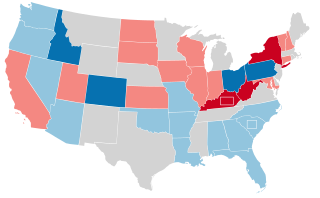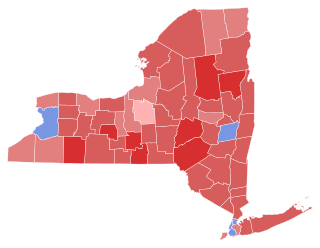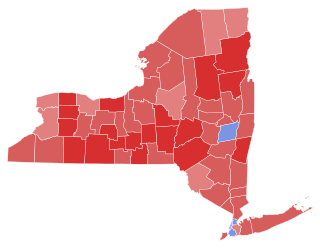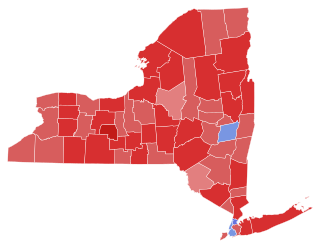Republican nomination
Campaign
Jacob Javits began his campaign for the Republican nomination as early as 1954, almost immediately upon taking office as Attorney General. [5] He openly solicited support from key leaders around the state, going around his party to do so. In essence, he was able to wall off the nomination before another strong candidate could challenge him. [5]
During the pre-convention campaign, Javits was criticized by fellow Republicans for being soft on communism, particularly during his time in Congress. He voted against the Mundt-Nixon Bill, which would have required registration of Communist Party members, and was one of only 10 Representatives to vote against a wiretap bill sponsored by his New York colleague Kenneth Keating. [6] In September, he testified before the Senate Internal Security Subcommittee to "clear his name" regarding rumors linking him personally to the Communist Party, including ex-communist Bella Dodd's testimony that she had guided Javits's early political career. He testified that he had "no connections" to Communists and that his House record was "effectively anti-Communist." Though he admitted he had met with Dodd in 1946, he said he had not known she was a Communist Party activist. [7] He had in fact voted for a number of measures opposed by communists, primarily on international affairs and national security, including the Marshall Plan, aid to Greece, Turkey, and Korea, extension of the draft, and appropriations for national defense. [6]
Javits also faced criticism for his liberalism more generally, [6] especially on those occasions when he opposed the Eisenhower administration. [5] In the 81st Congress, he voted with his party only 27 percent of the time. During the 82nd Congress, when Republicans were returned to the minority, he voted the Republican line only 15 percent of the time versus 80 percent for the average Republican. [6] He voted in favor of public housing, expansion of the Tennessee Valley Authority, state ownership of the Niagara power plant, and federal consumer and industrial regulations. He voted against the Taft-Hartley Act and the Immigration and Nationality Act of 1952. [6] Because of Javits's tendency to break from the party, some Republicans hoped to engineer the nomination of former Governor Thomas E. Dewey or Herbert Brownell instead. [6] Most, however, feared that nominating a less popular candidate would harm President Eisenhower's chances in New York. [5]
Most of the criticism of Javits came from upstate New York and eventually settled on J. Raymond McGovern, the former state Comptroller, as its standard-bearer. [4] [8] Two far stronger candidates, Governor Dewey and Douglas MacArthur, declined to back movements to draft them as candidates, though Dewey's denial was far more emphatic. A third candidate, Dean Alfange, withdrew after finding little support among delegates. [4]
Convention
By the time the convention arrived on September 10, Javits had withstood most of the criticism against him and an alternative had failed to emerge. In a crucial private meeting before the convention, the executive committee of the party endorsed Javits by a vote of 17 to 8 for McGovern. Failed attempts were made to present Dewey or MacArthur as alternatives. Discussion of Javits's alleged ties to communists were discussed, but the committee members agreed that Javits had acquitted himself well before the Senate subcommittee. Supporters on the committee argued that any losses upstate would be made up by gains in New York City. [4]
The vote was then made formally unanimous, with the dissenters agreeing not to publicly criticize Javits or allow their names to be used. [5] Javits appeared before the committee to accept the nomination. [4]
The convention met on September 10 and nominated Javits unanimously. [9] McGovern gave the nominating speech for Javits, having bowed out upon realization that he could not win.

The 1964 United States Senate elections were held on November 3. The 33 seats of Class 1 were contested in regular elections. Special elections were also held to fill vacancies. They coincided with the election of President Lyndon B. Johnson by an overwhelming majority, to a full term. His Democratic Party picked up a net two seats from the Republicans. As of 2022, this was the last time either party has had a two-thirds majority in the Senate, which would have hypothetically allowed the Senate Democrats to override a veto, propose constitutional amendments, convict and expel certain officials, or invoke cloture without any votes from Senate Republicans. In practice, however, internal divisions effectively prevented the Democrats from doing so. The Senate election coincided with Democratic gains in the House in the same year.

The 1956 United States Senate elections were elections for the United States Senate that coincided with the re-election of President Dwight D. Eisenhower. The 32 seats of Class 3 were contested in regular elections, and three special elections were held to fill vacancies. Although Democrats gained two seats in regular elections, the Republicans gained two seats in special elections, leaving the party balance of the chamber unchanged.

The 1958 New York state election was held on November 4, 1958, to elect the governor, the lieutenant governor, the state comptroller, the attorney general, a judge of the New York Court of Appeals and a U.S. Senator, as well as all members of the New York State Assembly and the New York State Senate.

The 1974 New York state election was held on November 5, 1974, to elect the governor, the lieutenant governor, the state comptroller, the attorney general, two judges of the New York Court of Appeals and a U.S. Senator, as well as all members of the New York State Assembly and the New York State Senate.

The 1962 New York state election was held on November 6, 1962, to elect the governor, the lieutenant governor, the state comptroller, the attorney general, a judge of the New York Court of Appeals and a U.S. Senator, as well as all members of the New York State Assembly and the New York State Senate.

The 1950 New York state election was held on November 7, 1950, to elect the governor, the lieutenant governor, the state comptroller, the attorney general and a U.S. Senator, as well as all members of the New York State Assembly and the New York State Senate.

The 1946 New York state election was held on November 5, 1946, to elect the governor, the lieutenant governor, the state comptroller, the attorney general, a U.S. Senator, the chief judge and an associate judge of the New York Court of Appeals, as well as all members of the New York State Assembly and the New York State Senate.

The 1942 New York state election was held on November 3, 1942, to elect the governor, the lieutenant governor, the state comptroller, the attorney general and two U.S. Representatives At-large, as well as all members of the New York State Assembly and the New York State Senate.

The 1938 New York state election was held on November 8, 1938, to elect the governor, the lieutenant governor, the state comptroller, the attorney general, two U.S. Senators and two U.S. Representatives-at-large, as well as all members of the New York State Assembly and the New York State Senate. The 1938 election was the first election where the Governor of New York was elected to a four-year term, rather than a two-year term.

The 1936 New York state election was held on November 3, 1936, to elect the governor, the lieutenant governor, the state comptroller, the attorney general, a judge of the New York Court of Appeals and two U.S. Representatives-at-large, as well as all members of the New York State Assembly and the New York State Senate.

The 1934 New York state election was held on November 6, 1934, to elect the governor, the lieutenant governor, the state comptroller, the attorney general, a U.S. Senator, two U.S. Representatives-at-large, the chief judge and two associate judges of the New York Court of Appeals, as well as all members of the New York State Assembly and the New York State Senate.

The 1928 New York state elections were held on November 6, 1928, to elect the governor, the lieutenant governor, the state comptroller, the attorney general, a U.S. Senator and a judge of the New York Court of Appeals, as well as all members of the New York State Assembly and the New York State Senate.

The 1914 New York state election was held on November 3, 1914, to elect the governor, the lieutenant governor, the Secretary of State, the state comptroller, the attorney general, the state treasurer, the state engineer, a U.S. Senator and a judge of the New York Court of Appeals, as well as all members of the New York State Assembly and the New York State Senate, and delegates-at-large to the New York State Constitutional Convention of 1915.

The 1940 New York state election was held on November 5, 1940, to elect three judges of the New York Court of Appeals, a U.S. Senator and two U.S Representatives-at-large, as well as all members of the New York State Assembly and the New York State Senate.

The 1944 New York state election was held on November 7, 1944, to elect a judge of the New York Court of Appeals and a U.S. senator, as well as all members of the New York State Assembly and the New York State Senate.

The 1949 New York state election was held on November 8, 1949, to elect a judge of the New York Court of Appeals and a U.S. Senator.

The 1952 United States Senate election in New York was held on November 4. Incumbent Republican Senator Irving M. Ives was re-elected to a second term in office over Democrat John Cashmore with a then-record margin of victory.

The 1964 United States Senate election in New York was held on November 3, 1964. Incumbent Republican U.S. Senator Kenneth Keating ran for re-election to a second term, but was defeated by Robert F. Kennedy.

The 1968 New York state election was held on November 5, 1968, to elect a judge of the New York Court of Appeals and a U.S. Senator, as well as all members of the New York State Assembly and the New York State Senate.

The 1934 United States Senate election in New York was held on November 6, 1934, to elect a U.S. Senator. Incumbent Democratic Senator Royal Copeland was re-elected to a third term in office, though he would die in office in 1938.



















